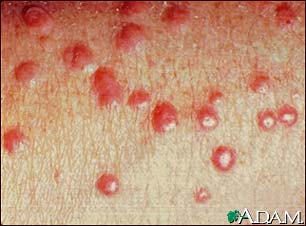Eruptive xanthomatosis
Eruptive xanthoma; Eruptive xanthomata; Xanthoma - eruptive; Diabetes - xanthoma
Eruptive xanthomatosis is a skin condition that causes small yellow-red bumps to appear on the body. It can occur in people who have a very high blood triglyceride level. These people also frequently have diabetes.
Causes
Eruptive xanthomatosis is a rare skin condition caused by an excessively high triglyceride level in the blood. It can occur in people with poorly-controlled diabetes or in people who take some medicines, such as isotretinoin, estrogens, and cyclosporine, which can increase the triglyceride levels.
Cholesterol and triglycerides are types of fats that naturally occur in your blood. High levels increase the risk for heart disease and other health problems.
When diabetes is not well-controlled, the insufficient insulin level makes it harder for the body to break down fats in the blood. This increases the level of fats in the blood. The extra fat can collect under the skin to form small bumps which are xanthomas.
Symptoms
The skin bumps may vary in color from yellow, orange-yellow, red-yellow, to red. A small red halo may form around the bump. The bumps are:
- Pea-sized
- Waxy
- Firm
While harmless by themselves, the bumps may be itchy and tender. They tend to appear on the:
- Buttocks
- Shoulders
- Arms
- Thighs
- Legs
Exams and Tests
Your health care provider will take your medical history and examine your skin. You may have the following blood tests:
- Blood test for cholesterol and triglycerides
- Blood sugar test for diabetes
- Pancreatic function test
A skin biopsy may be done to help diagnose the condition.
Treatment
Treatment for eruptive xanthomatosis involves lowering:
- Blood triglyceride
- Blood sugar
- Stopping or decreasing the dose of culprit medicines
Your provider will ask you to make changes in your lifestyle and diet. This can help lower high blood fats.
If you have diabetes, your provider will ask you to manage your blood sugar through diet, exercise, and medicines.
If lifestyle changes do not work, your provider may ask you to take medicines to help lower blood fat levels, such as:
- Statins
- Fibrates
- Lipid-lowering antioxidants
- Niacin
- Bile acid resins
The skin bumps go away by themselves after few weeks. They clear once the blood sugar and fat levels are under control.
Possible Complications
If not treated, high triglyceride levels can lead to pancreatitis.
When to Contact a Medical Professional
Contact your health care provider if you:
- Have poor control of diabetes
- Notice yellowish-red bumps on your skin
Prevention
Control of blood fats and blood sugar can help prevent this condition. Follow your provider's treatment recommendations.
References
Ahn CS, Yosipovitch G, Huang WW. Diabetes and the skin. In: Callen JP, Jorizzo JL, Zone JJ, Piette WW, Rosenbach MA, Vleugels RA, eds. Dermatological Signs of Systemic Disease. 5th ed. Philadelphia, PA: Elsevier; 2017:chap 24.
Braunstein I. Cutaneous manifestations of lipid disorders. In: Callen JP, Jorizzo JL, Zone JJ, Piette WW, Rosenbach MA, Vleugels RA, eds. Dermatological Signs of Systemic Disease. 5th ed. Philadelphia, PA: Elsevier; 2017:chap 26.
Fitzpatrick JE, High WA, Kyle WL. Yellow lesions. In: Fitzpatrick JE, High WA, Kyle WL, eds. Urgent Care Dermatology: Symptom-Based Diagnosis. Philadelphia, PA: Elsevier; 2018:chap 33.
Patterson JW. Cutaneous infiltrates - nonlymphoid. In: Patterson JW, ed. Weedon's Skin Pathology. 5th ed. Philadelphia, PA: Elsevier; 2021:chap 41.
White LE, Horenstein MG, Shea CR. Xanthomas. In: Lebwohl MG, Heymann WR, Coulson IH, Murrell DF, eds. Treatment of Skin Disease. 6th ed. Philadelphia, PA: Elsevier; 2022:chap 256.
Review Date: 11/30/2022












